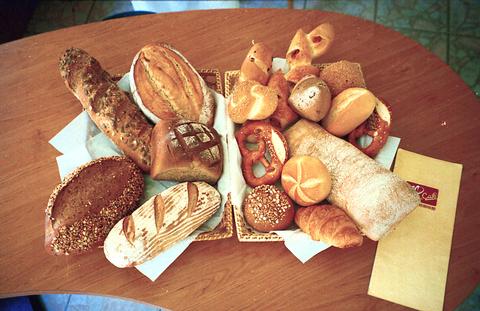Unlike many of Taipei's bakeries that fill their window displays with birthday cakes, breads of differing appearances and pastries of all shapes, the huge glass facade of the Wendel Backerei & Cafe reveals little of the expert baking that takes place within.
The German-style bakery is so unlike many of the city's more ostentatious bakeries in fact, that you could quite easily amble past without noticing it at all. That would be a shame if you enjoy baked goods.

PHOTO: GAVIN PHIPPS, TAIPEI TIMES
For the past two years, German national, Michael Wendel, has been baking up a smorgasbord of some of the most authentic Europe breads, including rye, grain, pumpkin and pumpernickel, rolls, cakes, pies and pretzels to be found in Taipei.
"I don't make my bread or cakes to suit local tastes," Wendel said. "I make sure they're all authentic." By authentic, Wendel means the breads aren't loaded with sugar and other sweeteners, which is one of the main reasons behind his bakery's popularity.
Wendel's store is also popular as a very reasonably-priced European-style bistro, offering diners a choice of savory German fare, such as smoked pork loin, roast chicken, Nurnberger sausage, Frankfurters, mashed potatoes and, of course, sauerkraut.
With set meals ranging in price from NT$110 to NT$260, dining at Wendel's certainly won't break the bank. What could give diners a dilemma, however, is choosing a dessert.
Along with such German staples as Black Forest cake, apple cake, Linzer torte and butter cake, there are countless other yummy pastries, pies and cakes to confound any sweet-toothed diner.
While there is little in the way of interior decor to the Wendel Backerei & Cafe, patrons are afforded a pleasant and airy environment in which to dine on simple and hearty German cuisine. The menu also includes several pasta dishes (NT$100 to NT$120) and submarine sandwiches (NT$90 to NT$110).
In addition to baking up a daily selection of rolls, breads and pastries, Wendel will prepare special breads and bulk orders on request -- should the ingredients be available.

May 11 to May 18 The original Taichung Railway Station was long thought to have been completely razed. Opening on May 15, 1905, the one-story wooden structure soon outgrew its purpose and was replaced in 1917 by a grandiose, Western-style station. During construction on the third-generation station in 2017, workers discovered the service pit for the original station’s locomotive depot. A year later, a small wooden building on site was determined by historians to be the first stationmaster’s office, built around 1908. With these findings, the Taichung Railway Station Cultural Park now boasts that it has

Wooden houses wedged between concrete, crumbling brick facades with roofs gaping to the sky, and tiled art deco buildings down narrow alleyways: Taichung Central District’s (中區) aging architecture reveals both the allure and reality of the old downtown. From Indigenous settlement to capital under Qing Dynasty rule through to Japanese colonization, Taichung’s Central District holds a long and layered history. The bygone beauty of its streets once earned it the nickname “Little Kyoto.” Since the late eighties, however, the shifting of economic and government centers westward signaled a gradual decline in the area’s evolving fortunes. With the regeneration of the once

The latest Formosa poll released at the end of last month shows confidence in President William Lai (賴清德) plunged 8.1 percent, while satisfaction with the Lai administration fared worse with a drop of 8.5 percent. Those lacking confidence in Lai jumped by 6 percent and dissatisfaction in his administration spiked up 6.7 percent. Confidence in Lai is still strong at 48.6 percent, compared to 43 percent lacking confidence — but this is his worst result overall since he took office. For the first time, dissatisfaction with his administration surpassed satisfaction, 47.3 to 47.1 percent. Though statistically a tie, for most

In February of this year the Taipei Times reported on the visit of Lienchiang County Commissioner Wang Chung-ming (王忠銘) of the Chinese Nationalist Party (KMT) and a delegation to a lantern festival in Fuzhou’s Mawei District in Fujian Province. “Today, Mawei and Matsu jointly marked the lantern festival,” Wang was quoted as saying, adding that both sides “being of one people,” is a cause for joy. Wang was passing around a common claim of officials of the People’s Republic of China (PRC) and the PRC’s allies and supporters in Taiwan — KMT and the Taiwan People’s Party — and elsewhere: Taiwan and